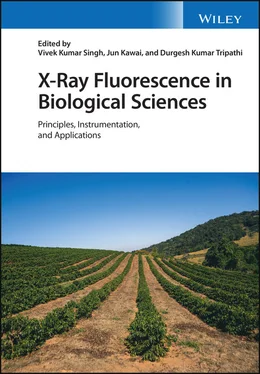X-Ray Fluorescence in Biological Sciences
Здесь есть возможность читать онлайн «X-Ray Fluorescence in Biological Sciences» — ознакомительный отрывок электронной книги совершенно бесплатно, а после прочтения отрывка купить полную версию. В некоторых случаях можно слушать аудио, скачать через торрент в формате fb2 и присутствует краткое содержание. Жанр: unrecognised, на английском языке. Описание произведения, (предисловие) а так же отзывы посетителей доступны на портале библиотеки ЛибКат.
- Название:X-Ray Fluorescence in Biological Sciences
- Автор:
- Жанр:
- Год:неизвестен
- ISBN:нет данных
- Рейтинг книги:5 / 5. Голосов: 1
-
Избранное:Добавить в избранное
- Отзывы:
-
Ваша оценка:
- 100
- 1
- 2
- 3
- 4
- 5
X-Ray Fluorescence in Biological Sciences: краткое содержание, описание и аннотация
Предлагаем к чтению аннотацию, описание, краткое содержание или предисловие (зависит от того, что написал сам автор книги «X-Ray Fluorescence in Biological Sciences»). Если вы не нашли необходимую информацию о книге — напишите в комментариях, мы постараемся отыскать её.
Discover a comprehensive exploration of X-ray fluorescence in chemical biology and the clinical and plant sciences X-Ray Fluorescence in Biological Sciences: Principles, Instrumentation, and Applications
X-Ray Fluorescence in Biological Sciences: Principles, Instrumentation, and Applications
X-Ray Fluorescence in Biological Sciences — читать онлайн ознакомительный отрывок
Ниже представлен текст книги, разбитый по страницам. Система сохранения места последней прочитанной страницы, позволяет с удобством читать онлайн бесплатно книгу «X-Ray Fluorescence in Biological Sciences», без необходимости каждый раз заново искать на чём Вы остановились. Поставьте закладку, и сможете в любой момент перейти на страницу, на которой закончили чтение.
Интервал:
Закладка:
Technically, the LIBS method is quite similar to other laser‐based analytical methods, where most of the hardware setup is same. LIBS can also be combined with Raman spectroscopy, and fluorescence (Laser induced fluorescence : LIF) [3, 5, 19]. Now‐a‐days, the manufactured devices combine these techniques in a single instrument, thereby allowing the atomic, molecular and structural characterization of a specimen, thus giving a deeper insight into the physical properties of it.
1.3.6 Proton‐Induced X‐Ray Emission (PIXE)
PIXE technique involves the detection of X‐rays emitted from the sample due to the bombardment of the sample with high energy ions [3, 20]. Different types of excitation beams produce X‐rays with energies which are characteristic of the elements present in the sample. Electron excitation in an electron microprobe (SEM) gives rise to EDXRF or WDXRF, which depends on the X‐ray dispersion and detection mode. Charged particle beams of He 2+or H +gives rise to PIXE spectroscopy. In all these spectroscopic methods, the excitation beam removes a core electron, which creates a vacancy, causing outer shell electrons to jump down to fill the inner shell vacancy. Thus, X‐rays are emitted with specific energies which are characteristic to the elements present in the sample. This accessory is very beneficial for identifying heavy elements by Rutherford backscattering spectrometry (RBS) [3]. These heavy elements show only small differences in RBS backscattered energies because of their similar masses, but there are distinct differences in their PIXE spectral studies. Being a non‐destructive analytic technique, PIXE offers signal levels similar to its electron beam counterparts, but provides better signal/background ratios. In electron spectroscopy, the background arises from bremsstrahlung and this is absolutely absent in PIXE due to the use of He 2+or H +ions [3]. PIXE can analyze insulating samples which cannot be detected by electron‐induced spectroscopy. However, some limitations are also present, such as the analysis area is limited to 1–2 mm and useful information can be obtained to only ~1 μm depth of samples with good accuracy.
Recent developments in PIXE use tightly‐focused beams to enhance the ability of microscopic analysis. This technique is called micro‐PIXE [3, 21] and is used for determining the distribution of trace elements in a wide range of samples. A similar technique, particle‐induced gamma‐ray emission (PIGE) [3, 22] is used to detect some light elements. PIXE is a better method than the traditional XRF techniques as it can detect the elements and their ratio too. On the other hand, SRXRF is better than PIXE.
Table 1.3 Advantages and limitations of SEM‐EDS method [3, 8].
| Advantages | Limitations |
|---|---|
| Quick identification of elementsProvides high‐resolution imagingExcellent depth of field for 3D appearance of the specimen image ( ~100Xthat of Optical microscopy)Versatile platform and supports many other analytical techniquesPossibility of imaging of insulating and hydrates samples in low vacuum mode | Size restriction which requires cutting of the samplesNeed to etch planar samples for contrastUltimate resolution is a strong function of the sample chemistry and stability in the electron beam |
1.3.7 Scanning Electron Microscopy–Energy Dispersive X–Ray Spectroscopy (SEM‐EDS)
SEM provides high‐resolution images of the sample surfaces [1–3, 8, 9]. It is the most popular analytical tool as it can quickly provide the detailed and good quality images of the sample. It can be coupled to an auxiliary EDS detector and provide elemental identification for most of the elements of the entire periodic table. SEM‐EDS is used where optical microscopy cannot provide sufficient image resolution of sufficient magnification. It also produces detailed surface topography images [3, 8]. Some of the advantages and limitations of SEM‐EDS are tabulated in Table 1.3.
In SEM‐EDS, the sample is scanned by the electron‐beam of the microscope and the different interactions are employed to obtain the images using secondary or backscattered electrons. Additionally, elemental analysis of the samples is performed by using the excitation of fluorescence radiation. Therefore, using the information obtained by images and elemental contents, the samples can be compared directly.
From Table 1.1, it is clear that μ‐XRF and SEM‐EDS possess different spatial resolutions and also have some differences for elemental detection [3, 8]. However, the main differences exist in terms of specific sample handling and some analytical capabilities.
1.3.7.1 Differences in XRF and SEM‐EDS (Sample Handling, Experimental Conditions, Sample Stress, and Excitation Sources)
There are some differences in XRF and SEM‐EDS such as sample handling, experimental conditions, sample stress, and excitation sources [1, 8]. Sample handling processes for XRF are quite easy when compared to those used for SEM‐EDS. Unlike for SEM‐EDS, the electrical conductivity requirement of the sample is not needed for μ‐XRF [3, 8]. In SEM analysis, the excitation is carried out by electrons which transport electrical charges to the sample. These charges have to be removed, and therefore the sample must be electrically conductive. Otherwise, image quality and quantification are affected. In cases of a non‐electrical conducting samples, coating by carbon (C) or gold (Au) of the samples is quite important. In SEM analysis, this is the only additional effort needed for analyzing samples such as glass, minerals, and plastics. On the other hand, these kinds of samples are analyzed directly using μ‐XRF, which reduces the sample preparation time significantly.
During SEM experimentation, sample surface must be of a very high quality due to the low penetration depth of electrons inside the materials. Thus, polishing of the sample needs more attention for better results. On the contrary, this kind of sample treatment is not required for μ‐XRF analysis.
μ‐XRF analysis can also be performed in air or pre‐vacuum. Due to this advantage of μ‐XRF, vacuum‐sensitive materials (organic samples) are easily analyzed [3, 8]. Also, simple liquids or wet samples such as pastes, slurry, etc. can also be analyzed quickly. This makes μ‐XRF applicable for a wide range of materials. Sometimes a vacuum condition is needed for μ‐XRF just to avoid the absorption of the fluorescence radiation in air, and thus 10–50 mbar pressures are sufficient. In SEM analysis, the absorption of electrons must be avoided and thus pressures required are in the range down to 0.01 mbar.
Some differences also exist between the excitation by X‐rays in XRF and by electrons in SEM with respect to the sample stress. The absorption of electrons by the target material is accompanied by a higher impact of energy into the material that heats up the material and stresses it. Sometimes, it damages the materials. Contrarily, the absorption of X‐rays did not produce high energy impact into the sample, and thus the heating effect is negligible, which reduces the sample stress. Therefore, higher excitation intensities can be used for μ‐XRF analysis.
A comparison of the analytical performances of XRF and SEM‐EDS indicates the differences for sensitivity particularly for analysis of traces. To analyzed trace elements, the sensitivity mainly depends on the peak/background ratio [23]. For electron excitation, the background intensity is higher because of the bremsstrahlung of the electron beam. The spectral background for X‐ray excitation is mainly due to the scattering of the bremsstrahlung of the tube on the sample. The other factor that influences peak/background ratio is the peak‐intensity which is determined by the quantity of the element and also by its excitation efficiency i.e. the excitation conditions and the cross‐sections for the excitation. Figure 1.4clearly shows the excitation efficiency for electrons and X‐rays that indicates that the cross section of electrons and X‐rays for exciting the K‐shell depends on the atomic numbers of the atoms [23]. This diagram reveals the high efficiency (high cross section) of electron excitation for lighter elements. In electron microscopes, lighter elements can easily be detected; even boron (B) or beryllium (Be) can be measured. However, heavy elements can be detected easily by excitation with X‐rays with better efficiency. Therefore, all the elements with atomic number greater than 20 (such as Ca) exhibit higher peak intensities and better sensitivities with X‐ray excitation [23]. This also results in better LODs in the case of heavy elements, as demonstrated in Figure 1.5[23].
Читать дальшеИнтервал:
Закладка:
Похожие книги на «X-Ray Fluorescence in Biological Sciences»
Представляем Вашему вниманию похожие книги на «X-Ray Fluorescence in Biological Sciences» списком для выбора. Мы отобрали схожую по названию и смыслу литературу в надежде предоставить читателям больше вариантов отыскать новые, интересные, ещё непрочитанные произведения.
Обсуждение, отзывы о книге «X-Ray Fluorescence in Biological Sciences» и просто собственные мнения читателей. Оставьте ваши комментарии, напишите, что Вы думаете о произведении, его смысле или главных героях. Укажите что конкретно понравилось, а что нет, и почему Вы так считаете.











